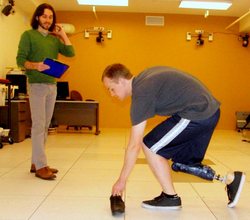
In a first-of-its-kind study, the Northwestern University Prosthetics-Orthotics Center has proven that an existing test of balance is also an effective measure for evaluating stability in individuals with lower limb amputation.
The Berg Balance Scale (BBS) was developed in the late ’80s as a way to assess balance and functional mobility in elderly individuals and has since become a well-established and widely used clinical-outcome measure. The test can be re-administered every few months to determine if a rehabilitation regimen has been effective at increasing a patient’s functional mobility, including a reduction in falls.
The BBS has been validated with various other patient groups, including those who suffer from spinal cord injury, multiple sclerosis, brain injury, Huntington’s disease, and Parkinson’s disease. But before the recent publication in Archives of Physical Medicine and Rehabilitation, it had never been used to complete a comprehensive study of lower limb amputees.
Acknowledging the need for a standardized approach to measuring stability in this population, co-authors Matthew Major, PhD, a postdoctoral research fellow in physical medicine and rehabilitation, Stefania Fatone, PhD, associate professor of physical medicine and rehabilitation, and Elliot Roth, MD, chair of the department, evaluated various BBS tasks, and surveyed the number of falls in the past year, fear of falling, and daily mobility aid use in 30 lower limb amputees.
The scientists were able to validate the test as an adequate way of measuring balance in this population as compared to other, similar tests. The BBS also proved reliable in that anyone could administer it and achieve the same results for individual patients.
Although the BBS provided physicians with a snapshot of an individual’s mobility at a given point in time, the group found no correlation between test results and the number of falls a person sustained in the previous 12 months.
This could be the result of the generally high-score of all patients, the likelihood of something other than balance causing the falls, or the patient population’s comfortableness with prosthetics.
“Despite the validation of the BBS for balance, it is really not able to identify lower-limb amputees with greater likelihood of falling,” Major said. “This may be the result of the test not being challenging enough for community-dwelling, active amputees, and we hope to test that hypothesis.”
Over the next 12 months, the scientists plan to evaluate the responsiveness of the BBS by assessing individuals at the beginning of the rehabilitation process.
By evaluating people nearer the time when they receive their prosthesis, Major expects to see lower BBS scores that will improve over time. Results from that study could enhance their ability to refine the test and make it an effective way of determining fall risk and other balance issues for lower limb amputees. This information could then be used to tailor a patient’s rehabilitation regimen.
“Maybe we will find that we should not use the BBS for active patients, but that it can monitor people right after they receive a prosthetic to see balance develop and improve over time,” Major said.
The research was funded by a National Institute on Disability and Rehabilitation Research grant, the Northwestern University Clinical and Translational Sciences Institute, and the David Rubin, MD, Enrichment Fund.






